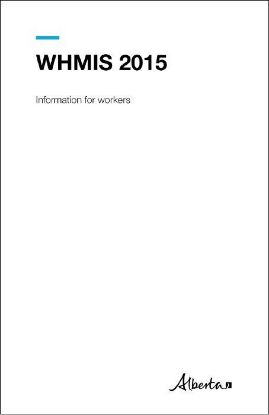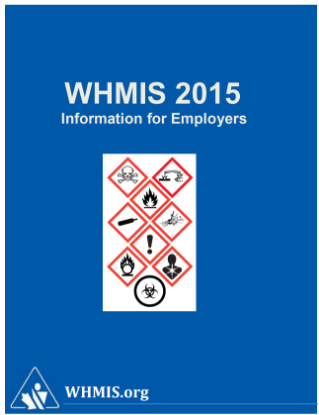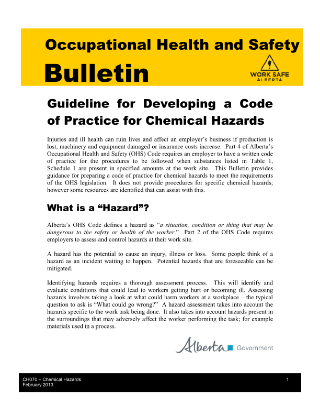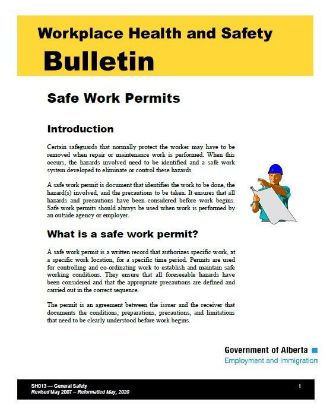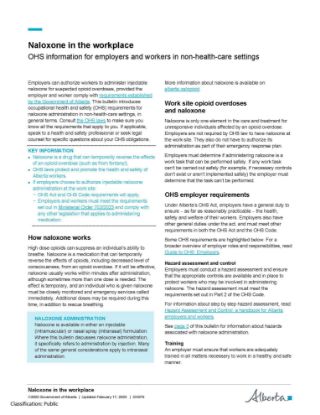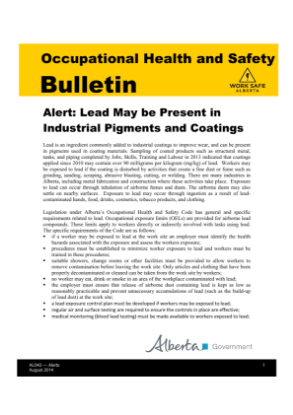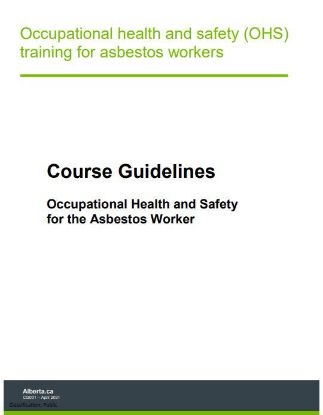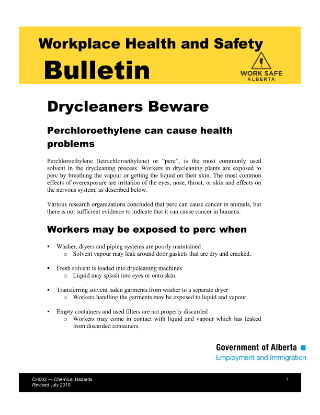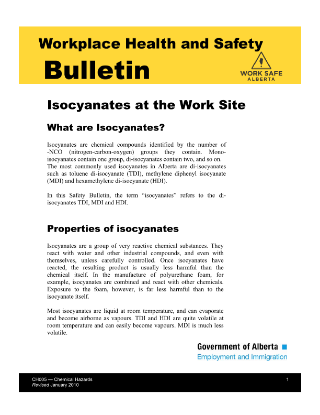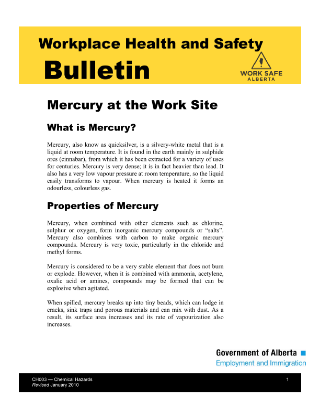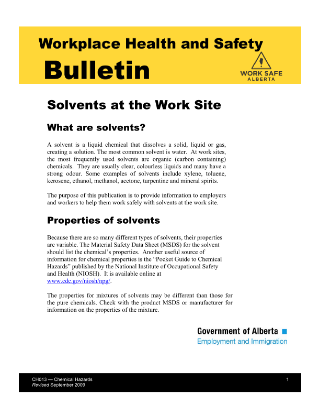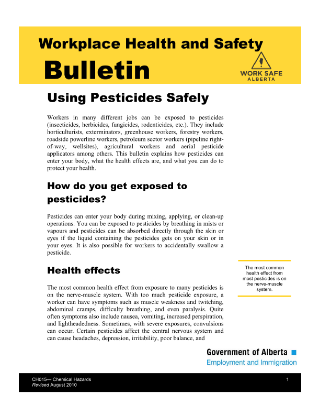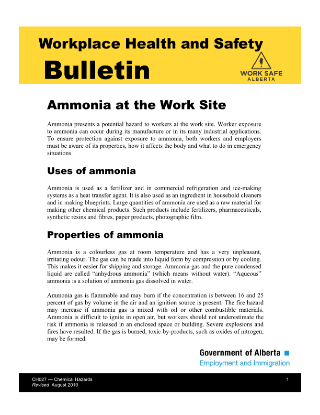You have no items in your order.
Hazards: chemical
WHMIS, as well as ammonia, asbestos, carbon monoxide, dusts, drugs, hydrogen sulphide, lead, pesticides, silica, solvents and cleaners, and more.
WHMIS 2015: Information for Workers
CH007
A detailed explanation of WHMIS requirements for workers. Available in print as a 5.5" x 8.5" booklet.
UPDATED: January 2022
UPDATED: January 2022
WHMIS 2015: Information for Employers
CH008
A detailed explanation of WHMIS requirements for employers. Available in print as a 5.5" x 8.5" booklet.
PUBLISHED: June 2018
PUBLISHED: June 2018
Guideline for Developing a Code of Practice for Chemical Hazards
CH070
***This resource is current to February 2013.
For information on the latest OHS requirements, visit OHS website.***
Presents a two-step process for employers to develop a workplace code of practice for chemical hazards.
PUBLISHED: February 2013
For information on the latest OHS requirements, visit OHS website.***
Presents a two-step process for employers to develop a workplace code of practice for chemical hazards.
PUBLISHED: February 2013
Safe Work Permits
SH013
***This resource is current to May 2020.
For information on the latest OHS requirements, visit OHS website.***
Explains how safe work permits can be used to protect workers and maintain safe working conditions. Provides examples and discusses pros and cons.
PUBLISHED: May 2020
For information on the latest OHS requirements, visit OHS website.***
Explains how safe work permits can be used to protect workers and maintain safe working conditions. Provides examples and discusses pros and cons.
PUBLISHED: May 2020
Naloxone in the workplace
CH076
Introduces - in general terms - OHS legal requirements that will apply if employers choose to authorize naloxone administration as part of an opioid overdose emergency response. Provides related links, including to Government of Alberta requirements.
UPDATED: February 2023
UPDATED: February 2023
Approved asbestos training agencies
ASB002
List of approved asbestos training agencies.
UPDATED: March, 2023
UPDATED: March, 2023
Alert: Lead May be Present in Industrial Pigments and Coatings
AL042
***This resource is current to August 2014.
For information on the latest OHS requirements, visit OHS website.***
An outline of the Alberta Occupational Health and Safety Code general and specific requirements related to lead.
PUBLISHED: Aug 2014
For information on the latest OHS requirements, visit OHS website.***
An outline of the Alberta Occupational Health and Safety Code general and specific requirements related to lead.
PUBLISHED: Aug 2014
Course Guidelines: Occupational Health and Safety for the Asbestos Worker
CG001
Summarizes the course content, worker re-certification and administrative procedure requirements for agencies approved to deliver the “Occupational Health and Safety for the Asbestos Worker” course.
UPDATED: April 2021
UPDATED: April 2021
Drycleaners Beware: Perchloroethylene can cause health problems
CH002
***This resource is current to June 2010.
For information on the latest OHS requirements, visit OHS website.***
Health risks associated with perchloroethylene or "perc" exposure and suggested controls.
PUBLISHED: June 2010
For information on the latest OHS requirements, visit OHS website.***
Health risks associated with perchloroethylene or "perc" exposure and suggested controls.
PUBLISHED: June 2010
Isocyanates at the Work Site
CH005
***This resource is current to January 2010.
For information on the latest OHS requirements, visit OHS website.***
Hazards associated with isocyanates and suggested controls.
PUBLISHED: January 2010
For information on the latest OHS requirements, visit OHS website.***
Hazards associated with isocyanates and suggested controls.
PUBLISHED: January 2010
Mercury at the Work Site
CH003
Health risks associated with mercury exposure, suggested alternatives and controls.
PUBLISHED: January 2010
PUBLISHED: January 2010
Solvents at the Work Site
CH013
***This resource is current to August 2009. For information on the latest OHS requirements, visit OHS website.***
Describes different types of solvents, potential hazards and suggested controls.
PUBLISHED:
PUBLISHED: August 2009
Describes different types of solvents, potential hazards and suggested controls.
PUBLISHED:
PUBLISHED: August 2009
Using Pesticides Safely
CH015
Discusses exposure to pesticides (insecticides, herbicides, fungicides, rodenticides, etc.), health complications and protective controls.
PUBLISHED: August 2010
PUBLISHED: August 2010
H2S: The Killer
CH026
***This resource is current to August 2012.
For information on the latest OHS requirements, visit OHS website.***
Lists the hazards for workers when working with H2S, suggested controls including protection and first aid, and employer and worker legislated responsibilities.
PUBLISHED: August 2012
For information on the latest OHS requirements, visit OHS website.***
Lists the hazards for workers when working with H2S, suggested controls including protection and first aid, and employer and worker legislated responsibilities.
PUBLISHED: August 2012
Ammonia at the Work Site
CH027
***This resource is current to August 2010.
For information on the latest OHS requirements, visit OHS website.***
Describes the properties of ammonia and how it affects the body, and addresses employer and worker legislated responsibilities.
PUBLISHED: August 2010
For information on the latest OHS requirements, visit OHS website.***
Describes the properties of ammonia and how it affects the body, and addresses employer and worker legislated responsibilities.
PUBLISHED: August 2010
